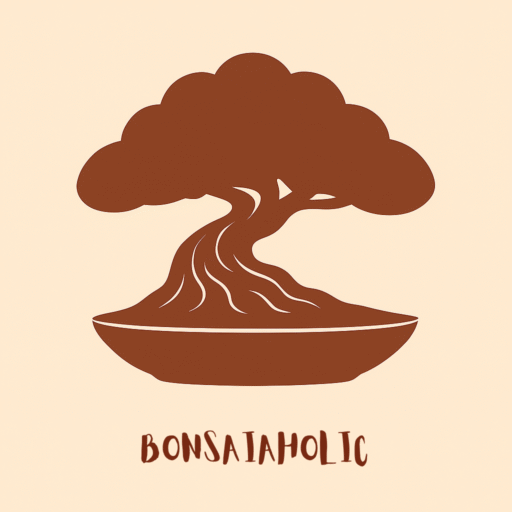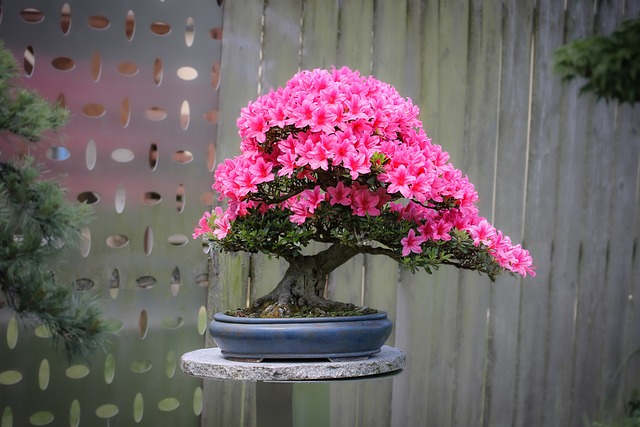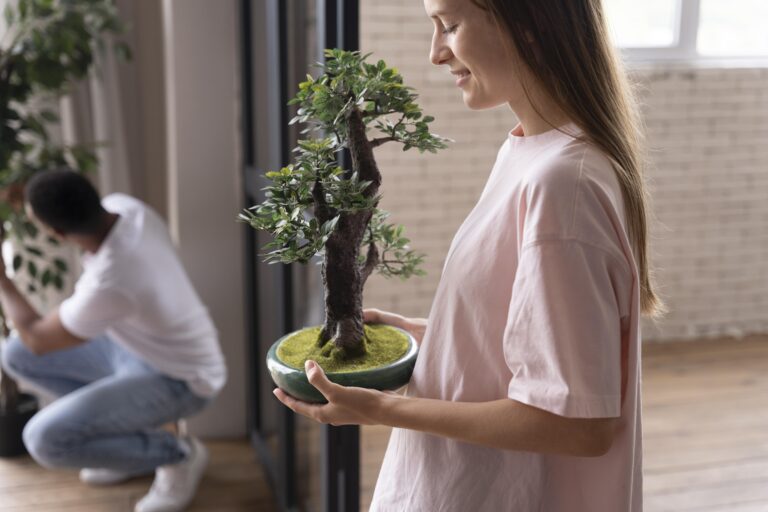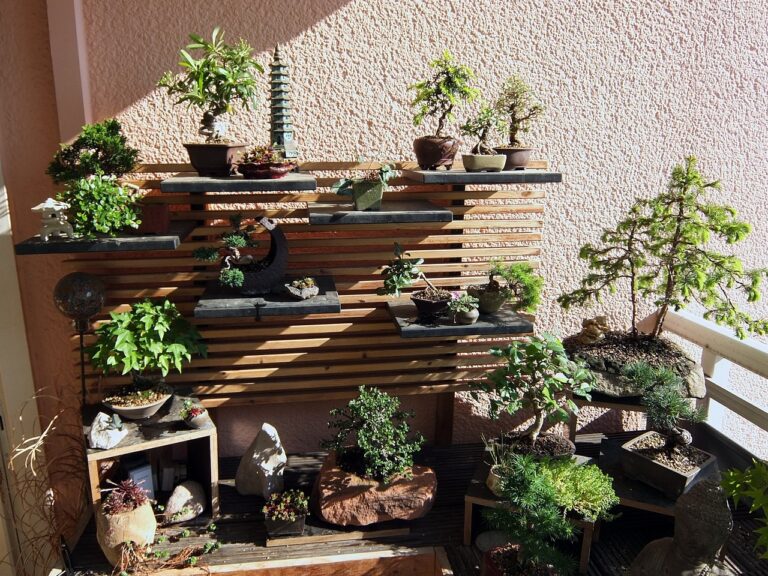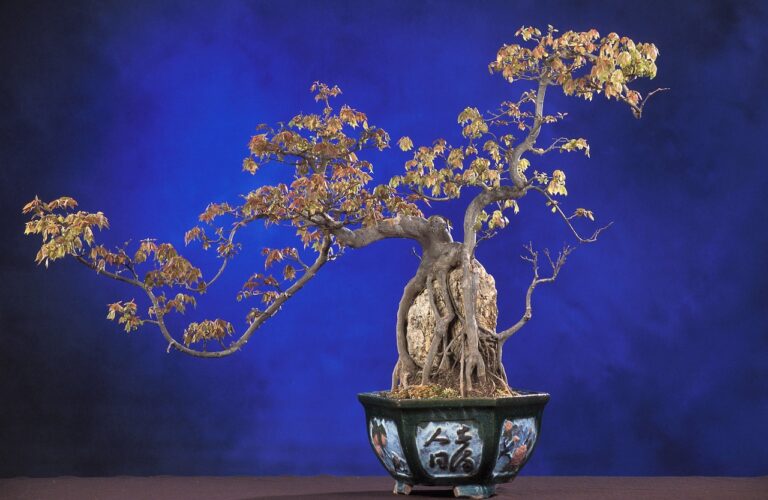Why and When Bonsai Trees Turn Yellow
Bonsai trees are delicate and intricate plants that require meticulous care to thrive. One common issue that bonsai owners face is the yellowing of leaves. Just like browning, yellowing can be an indicator of several underlying problems. When bonsai trees turn yellow, it’s often a sign that something in their environment, care routine, or health is off-balance. In this article, we’ll explore the reasons why bonsai trees turn yellow, when this yellowing occurs, and how to address and prevent it.
1. Understanding the Yellowing of Bonsai Trees
Yellowing in bonsai trees can be seen as a symptom rather than a disease. It often indicates stress or suboptimal conditions in terms of water, light, nutrients, or pests. Different parts of the tree, such as the leaves or needles (in the case of coniferous bonsai), can turn yellow for various reasons. Understanding the potential causes and addressing them promptly is crucial for the health of your bonsai.

2. Common Reasons Why Bonsai Trees Turn Yellow
a. Watering Issues
Watering plays a critical role in the health of any bonsai tree. Both overwatering and underwatering can result in the yellowing of leaves, but each type of watering issue affects the tree differently.
- Overwatering: When a bonsai tree is overwatered, the roots may become waterlogged, preventing them from getting the oxygen they need. This suffocation leads to root rot, which can cause the tree’s leaves to turn yellow before they eventually drop. Overwatered bonsai trees often have damp, soggy soil and may show signs of fungal growth.
- Underwatering: On the other hand, when a bonsai tree is not watered enough, it becomes dehydrated. The leaves will start to yellow as the tree conserves energy to maintain essential functions. Underwatered trees often have dry, brittle soil that pulls away from the pot’s edges, and the leaves may curl up as they yellow.
b. Lighting Issues
- Insufficient Light: Many bonsai species need bright, indirect light to thrive. If a tree is not receiving enough light, it will struggle to produce chlorophyll, the pigment that gives leaves their green color. The lack of chlorophyll causes the leaves to turn yellow, often starting from the lower branches and working its way up.
- Excessive Direct Sunlight: While bonsai trees need adequate light, too much direct sunlight can cause the leaves to scorch, leading to yellowing followed by browning. This is especially true for species that prefer indirect or filtered light, such as tropical bonsai varieties.
c. Nutrient Deficiencies
Bonsai trees, like all plants, need a balanced supply of nutrients to maintain their health. Yellowing can occur when a bonsai lacks essential nutrients.
- Nitrogen Deficiency: Nitrogen is one of the most important nutrients for plant growth, and a deficiency will typically result in yellowing leaves. Nitrogen is required for the production of chlorophyll, so when it’s lacking, the leaves turn yellow starting from the bottom of the tree and progressing upwards.
- Iron Deficiency (Chlorosis): Iron is necessary for plants to create chlorophyll. When iron is deficient, the tree’s leaves may turn yellow, especially between the veins, while the veins themselves remain green. This condition, called chlorosis, is common in bonsai trees that are planted in alkaline soil, as high pH levels can make iron unavailable to the roots.
- Magnesium Deficiency: Magnesium deficiency also causes yellowing, typically in older leaves. The veins remain green while the rest of the leaf turns yellow, similar to iron deficiency, but it starts with older leaves first.
d. Improper Soil Conditions
The type of soil used for bonsai trees plays a significant role in their overall health. Poor soil conditions can lead to root stress and nutrient imbalances, both of which can cause yellowing leaves.
- Poor Drainage: Bonsai soil should be well-draining to allow excess water to escape, preventing waterlogged roots. If the soil is too compact or not well-draining, water can accumulate around the roots, leading to oxygen deprivation and yellowing leaves.
- Soil pH Imbalance: The pH of the soil can affect the availability of nutrients to the bonsai. If the soil is too acidic or too alkaline, the tree may struggle to absorb the nutrients it needs, leading to deficiencies and yellowing. Testing and adjusting the soil pH can help address this issue.
e. Pests and Diseases
Pests and diseases can also be responsible for yellowing leaves in bonsai trees. Insect infestations and fungal diseases are common culprits.
- Insect Infestations: Pests such as aphids, spider mites, and scale insects can feed on the tree’s leaves, draining the sap and weakening the tree. This damage can cause leaves to turn yellow, wilt, and eventually drop. Affected trees may also have sticky residue or visible insects on the leaves and branches.
- Fungal Infections: Fungal diseases, such as root rot and powdery mildew, can cause yellowing leaves as well. Root rot, often caused by overwatering, prevents the roots from absorbing water and nutrients, which can lead to yellowing. Fungal infections like powdery mildew can spread on the surface of the leaves, creating yellow spots and eventually causing the leaves to fall off.
f. Environmental Stress
Environmental factors, such as temperature, humidity, and air quality, can stress bonsai trees and lead to yellowing leaves.
- Temperature Stress: Bonsai trees are sensitive to temperature changes. If the tree is exposed to extreme heat or cold, it may start to show signs of stress, including yellowing leaves. Tropical bonsai species, in particular, are vulnerable to cold temperatures and can develop yellow leaves if exposed to drafts or cold air.
- Low Humidity: Many bonsai species, especially tropical varieties, require high humidity to thrive. If the surrounding air is too dry, the leaves may lose moisture and turn yellow. Indoor environments, particularly in winter when heating is used, can lead to low humidity levels that stress bonsai trees.
- Air Pollution: Bonsai trees can also be affected by poor air quality, especially if they are placed near sources of pollutants like car exhaust or cigarette smoke. Polluted air can cause leaves to yellow as the tree struggles to absorb clean air for photosynthesis.
3. When Bonsai Trees Are Most Prone to Yellowing
Bonsai trees can turn yellow at different times depending on the cause of the issue. However, there are certain periods when yellowing is more likely to occur.
a. Seasonal Changes
- Autumn: If you have a deciduous bonsai tree, yellowing leaves in autumn are natural and not a cause for concern. Deciduous trees shed their leaves in the fall as part of their life cycle. The leaves will turn yellow, orange, or red before falling off, signaling that the tree is entering its dormant phase.
- Spring: During spring, new growth may appear yellow if the tree is not receiving enough nutrients. This is often a sign that the tree needs to be fertilized to support new leaf development.
b. After Repotting or Transplanting
- Transplant Shock: After repotting, bonsai trees can experience transplant shock, which may cause the leaves to turn yellow temporarily. This happens as the tree adjusts to its new environment and overcomes the stress of having its roots disturbed.
c. During Periods of Stress
- Inconsistent Watering: Periods of drought or overwatering can lead to yellowing, especially if the tree is not receiving a consistent amount of water. Keeping a stable watering schedule is important to prevent this.
- Nutrient Deficiencies: If a bonsai is not fertilized regularly, it may develop yellowing leaves over time due to nutrient deficiencies.
4. How to Address and Prevent Yellowing in Bonsai Trees
If your bonsai tree’s leaves have turned yellow, it’s important to diagnose the cause and take steps to correct it. Here’s how you can address and prevent yellowing:
a. Adjust Watering Practices
- Check Soil Moisture: Regularly check the soil moisture to ensure you are not overwatering or underwatering your bonsai. The soil should be slightly moist but not soggy.
- Improve Drainage: If the soil is not draining well, repot the tree into a soil mix designed for bonsai, which is well-draining and prevents water accumulation around the roots.
b. Ensure Proper Lighting
- Provide Adequate Light: Place your bonsai in a location where it receives the right amount of light for its species. If grown indoors, consider using artificial grow lights if natural light is insufficient.
- Prevent Sun Scorching: Protect your bonsai from excessive direct sunlight, especially during the hottest part of the day. A partially shaded location may be ideal for some species.
c. Fertilize Regularly
- Use Balanced Fertilizers: Fertilize your bonsai regularly with a balanced fertilizer that provides essential nutrients like nitrogen, iron, and magnesium. This helps prevent yellowing caused by nutrient deficiencies.
- Correct Specific Deficiencies: If you suspect a specific deficiency, such as iron or nitrogen, use a specialized fertilizer to address the problem.
d. Maintain Healthy Soil
- Repot as Needed: Repot your bonsai every 1-2 years to refresh the soil and ensure it remains well-draining and nutrient-rich.
- Check Soil pH: Test the soil pH and adjust it if necessary to keep it within the optimal range for your bonsai species.
e. Monitor for Pests and Diseases
- Inspect Regularly: Regularly inspect your bonsai for signs of pests or diseases. Early detection can prevent damage from escalating.
- Use Appropriate Treatments: If you detect pests or diseases, treat your bonsai with suitable pesticides or fungicides. Be sure to follow the instructions carefully to avoid harming the tree.
f. Protect Against Environmental Stress
- Control Temperature and Humidity: Keep your bonsai in an environment with stable temperatures and sufficient humidity, especially for tropical species. You can use a humidity tray or mist the leaves regularly to maintain adequate moisture levels.
- Ensure Clean Air: Avoid placing your bonsai in areas with poor air quality, and ensure it has access to fresh, clean air.
Conclusion
Yellowing leaves on a bonsai tree can be a signal that something is amiss in its care or environment. Whether caused by improper watering, nutrient deficiencies, poor lighting, or pests and diseases, it’s essential to identify and address the root cause to restore your bonsai’s health. By maintaining proper care practices, such as consistent watering, fertilization, and environmental control, you can prevent yellowing and ensure your bonsai thrives for years to come.
